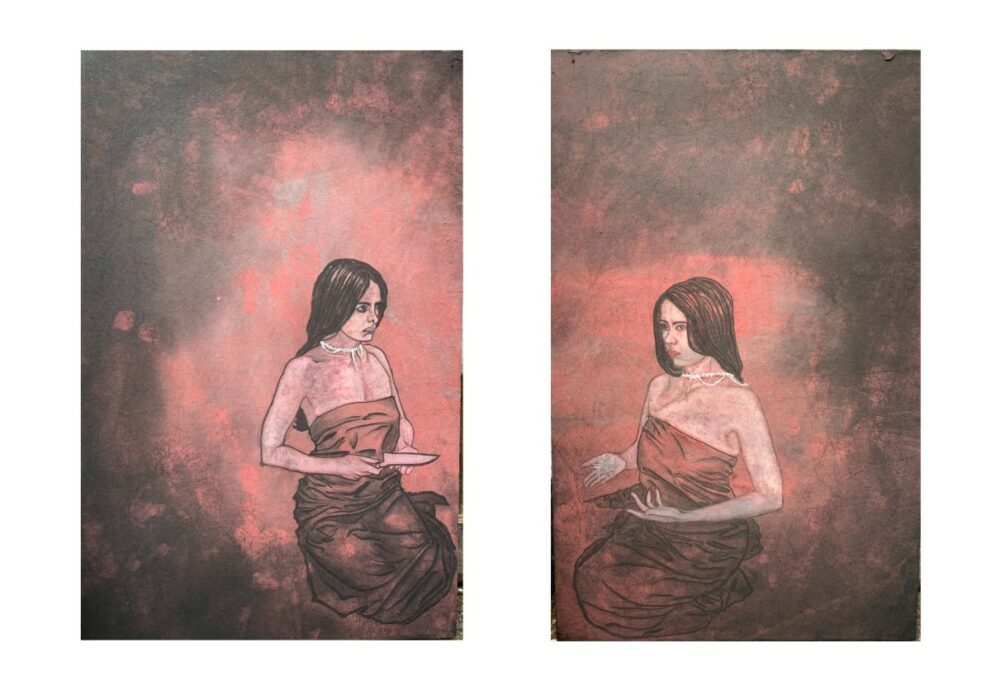The Ritual Diptych by Alice Smith: Exploring Hidden Feminine Energy and Witchy Allure
‘The Ritual Diptych‘ created by artist Alice Smith, is an intriguing artwork composed of two separate paintings designed to be hung side by side. The diptych showcases a dark and moody expression of hidden feminine energy, intertwined with strong witchy overtones. Each painting captures a different woman, each embodying a distinct aspect of the ritualistic theme.
Composition:
The diptych presents two paintings, visually connected yet distinct from one another. In the first painting, a woman holds a knife in her hand, the second painting features another woman with her hands open, holding a sprig of Sage.
Technique:
Alice Smith employs a unique technique in this artwork, utilising a crackled effect called ‘momigami’ on the paper. Momigami is a traditional Japanese technique where paper is treated with a combination of folding, wrinkling, and coating to create a distinctive crackled texture. This technique adds depth and texture to the diptych, enhancing the enigmatic atmosphere and complementing the underlying theme of transformation.
Display:
‘The Ritual Diptych’ is designed to be displayed with one painting placed horizontally next to the other. The unframed artwork is currently presented as two rolls of paper, highlighting the raw and organic nature of the piece. The positioning of the paintings side by side enhances the visual connection between the two women, inviting viewers to contemplate the relationship between their contrasting energies and interpret their symbolic significance.
Conclusion:
‘The Ritual Diptych’ by Alice Smith is a captivating artwork that delves into the realm of hidden feminine energy and witchy allure. Through its dark and moody ambiance, ambiguous ritualistic themes, and contrasting portrayals of women, the diptych invites viewers to explore the fervour and desires associated with supernatural transformation. The artist’s incorporation of the unique momigami technique adds an intriguing texture to the piece, further enhancing its enigmatic allure.
VIEW ALL PAINTINGS BY ALICE SMITH
Questions to the Artist about the Artwork
Can you share more about the inspiration behind ‘The Ritual Diptych’? What led you to explore the theme of hidden feminine energy and witchy overtones?
I have been interested in the subtle ways women have amassed power throughout history since I was studying for my Foundation course at Central Saint Martins. That’s where I first learned about the femme fatale and the post war film noir genre depicting women as dangerous seductresses setting traps to ensnare unsuspecting men. That demonisation of women inadvertently cements their power. Whether it’s a Hollywood actress like Rita Hayworth or a midwife in medieval England accused of witchcraft, women have had to carefully navigate a hostile world which has often sought their disenfranchisement. These are the ideas behind my painting ‘The Ritual’.
How did you choose the specific gestures and objects held by each woman in the diptych? What symbolism were you aiming to convey through these elements?
The gestures and objects are not based on anything in real life, but they convey the image of a certain kind of age-old witchcraft which I imagine women have partaken in for centuries. The woman on the left is holding a kitchen knife which I still own, and the woman on the right is holding a sprig of sage. I know sage is still used by many modern witches and people who practise spiritual rituals of cleansing. I don’t know anyone who uses kitchen knives for spiritual ceremonies, but it adds a certain drama to the figure, so I added it. The symbolism is linking any feminine presenting person with the power to utilise nature, plants and sacred objects for divine purpose, whatever that may be.
Could you explain the process of creating the crackled effect using the ‘momigami’ technique? What drew you to this particular technique and how do you feel it enhances the overall concept of the artwork?
This technique is rarely used in modern Japanese painting (Nihonga) anymore. I learnt it from a veteran Japanese woman at my first technical art college in Tokyo, where I learnt Chinese Ink Painting. You cover the paper in deep black ink and then apply a layer of a thick natural pigment over the top of it. When you scrunch up the paper the top layer of pigment cracks to reveal the black ink underneath in a random pattern. Then you iron out the paper and paint over it. I feel it adds an element of chance and random happy accident to the base layer of the work and you cannot predict where the cracks will form. For this piece it also enhances the idea of a liminal space between worlds where we are not quite in or out of one layer or the other.
Are there any personal experiences or influences that have shaped your artistic exploration of feminine power and supernatural desires?
As a queer artist, I definitely tend to fixate on the female form. As it is pride month, many LGBTQ people are reflecting on the sense of renewed dread we feel in the face of strong anti-trans sentiments across the western world. The need to regain autonomy in a society that doesn’t have a place for you, is ever present in my life and work. I often go over the same themes in my work until I have figured out what I need to learn through them. This piece helped me to dig deeper into my interest in modern spiritual practices. I wouldn’t call myself a witch, I don’t know enough to claim that label, but I am exploring the connection ancient people had to the seasons, wild growing plants and a strong link to nature that we all need to reconnect to in our digital age.
VIEW ALL PAINTINGS BY ALICE SMITH




